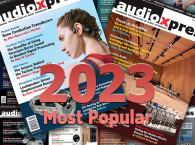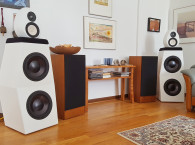 The July issue of audioXpress offers an extensive report on Audio Amplification technology, the brands, the strategies and the products that stood out for the past 12 months or more, from consumer ICs to powerful multichannel professional audio amplifiers. In “Evolution of the Species,” this new Market Update explains why audio amplifiers are getting better, smarter, integrated, connected, and multichannel, offering a complete analysis of this key product segment for the audio industry overall.
The July issue of audioXpress offers an extensive report on Audio Amplification technology, the brands, the strategies and the products that stood out for the past 12 months or more, from consumer ICs to powerful multichannel professional audio amplifiers. In “Evolution of the Species,” this new Market Update explains why audio amplifiers are getting better, smarter, integrated, connected, and multichannel, offering a complete analysis of this key product segment for the audio industry overall.
The last 12 months have been an exciting time for audio electronics, and in particular for audio amplification. Benefiting from expanded time for research and development allowed by the global COVID-19 pandemic, companies in general have used the pause in many market activities to reinforce their portfolios. Of course, many other companies have also used the time to redefine their strategies, and we've seen some interesting company moves, market repositioning, and strategic alignments.
Expanding on the topic of audio amplifiers, this issue includes a test and measurement article that throws an interesting perspective on the significant evolution of Class-D technology. "Audio Bandwidth Measurements in the Presence of Significant Out-of-Band Noise," is an article originally written in 2005 by Bruce Hofer - co-founder and chief analog designer at Audio Precision - and that remains 95% on target for 2022. As the latest generation of Class-D audio amplifiers challenges our ability to measure them, even with the latest APx analyzers, Hofer already debated the fundamentals with the early instrumentation of the time. As a side note, Stuart Yaniger conducted some reference measurements with the latest Class-D amplifiers.
And with the audio industry resuming its trade show calendar, Oliver A. Masciarotte offers a report from the 2022 edition of Audio Expo North America, better known as AXPONA - the most important annual hi-fi and high-end audio show in the US. As audio enthusiasts and audiophiles returned once again to listening in person at the Renaissance Schaumburg Convention Center Hotel, there was a lot to explore in very little time. As a veteran of the show, Masciarotte says it was a distinct pleasure to discover what was available in the rooms. Everyone he talked with, be it exhibitors or attendees, had good fun while enjoying an opportunity to listen to some exceptional systems. In this show report, Masciarotte details some of his highlights.

And from product listening impressions to DIY, this July 2022 issue brings another great project by Bruce Heran, with the “Cranberry Companion, a High-Performance Preamplifier Using Modular Construction.” Heran lives in Sierra Vista, AZ, and is an avid DIYer, having been involved in electronics for 59 years. audioXpress readers probably remember his "Cranberry" stereo vacuum tube amplifier project, published in audioXpress May 2021. Now the author decided to build also a companion preamplifier inspired by a modular approach and using solid-state components exclusively. The actual project features a phono, line and headphone preamplifier stages.
Next up, this issue offers another great DIY follow-up project, this time from Reinhard Metz. Most of our readers still remember Tom Perazella’s extraordinary egg speaker project with SB Acoustics Satori drivers, featured in the September, October, and November 2018 issues of audioXpress. Inspired by that design, Metz decided to build his own version, and also explore his own take with an active crossover tri-amp approach using a miniDSP 4x10HD system feeding a dedicated six-channel amplifier using Purifi 425W Class-D units. The new Egg Speaker Amp and System is an inspired take on the original, and an article that audioXpress is pleased to publish.
And no issue about audio amplifiers would be complete without our monthly column focused on everything tubes, Hollow-State Electronics. This month, Richard Honeycutt explores a topic that affects all DIY tube power amp designer/builders and their choices of output tubes. Specifically, what is the best way to achieve a triode sound with its low-order harmonics and performance consequences? This article discusses the practical approaches and implications of using a “triode-connected” pentode or beam power tube rather than a true triode. And, what are the performance downsides of using a triode-connected beam power tube or pentode rather than sticking with the pentode connection?
And finally, Ethan Winer continues his detailed approach to "Building a Guitar-Controlled Synthesizer." His three previous articles described key circuits he developed for a project that uses an electric guitar instead of a keyboard to control an analog synthesizer. This fourth article continues with two pieces needed to process input from an electric guitar: the input section’s preamplifier and noise gate, and the pick detector.

As always... A single issue with a strong focus on audio amplifiers with a broad perspective from market intelligence and new products, all the way to the best in DIY. A lot to explore now and many times later. Remember, every month, audioXpress brings innovations in audio, different topics in audio electronics, and the best in DIY audio, published 12 times per year, and available in print and online.
Subscribing to the digital online version allows immediate access and is available here: www.audioxpress.com/page/audioXpress-Subscription-Services.html
If you wish to buy a single printed issue or the complete audioXpress archive on USB, from 2000 to 2021 (yes, including the latest issue), just visit our online shop at www.cc-webshop.com
Don't miss out, get your copy of audioXpress right now at www.gotomyxpress.com






